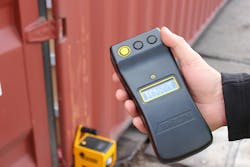Maximizing revenue for each container load is becoming more important as cargo receivers look constantly to drive down transport costs.
For New Zealand fish products group Talley’s this presented a unique challenge. The company’s seafood division — Amaltal Deepsea — runs a fleet of deep sea fishing vessels equipped with automated processing facilities. Fish are processed onboard within hours of being caught. Everything is used, including fish waste, which is converted into high-grade byproducts such as fish meal and oil. When exporting fish oil, Talley’s used a pump and hose to discharge the oil into a 24,000-liter flexitank.
But, the firm’s onshore logistics team faced a constant problem — how to maximize container loads of this liquid cargo? If the container is overfilled, the flexitank could split, destroying tens of thousands of dollars worth of cargo, not to mention creating a rather smelly clean up job. But by underfilling the container, Talley’s generate less revenue from the shipment, plus the shipping cost per ton of payload is higher than it needs to be.
Talley’s tried using flowmeters to optimize the load, but found this was inaccurate, with air bubbles and other variables skewing the measurement. This meant they were forced to "guess" when the flexitank was full, disconnect the hose, then have the container hauled to the nearest weighbridge to check the weight. With the gross container weight, Talley’s could calculate how much capacity was left inside the flexitank.
Containers were at times under-filled by more than 2,000 liters. Once weighed, the container would be returned for the team to continue loading and to guess (again) if it was topped up to the right level. This process cost Talley’s time and money, including extra haulage costs, weighbridge fees and man-hours spent coordinating the check weighing and top up. Check-weighing away from the loading point also caused delays and meant Talley’s sometimes had to choose between knowingly shipping an under filled container, or missing a shipping cut-off-time.
The firm was already familiar with BISON C-Jacks, industrial scales for weighing grounded shipping containers, having adopted them at a number of its meat processing plants for SOLAS VGM compliance (The International Maritime Organization regulation under the Safety of Life at Sea Convention (SOLAS) requires shippers to provide a Verified Gross Mass (VGM) for every packed container as a condition for vessel loading.)
Talley’s logistics team quickly recognized that these portable container scales were not just a compliance tool, but an ideal solution for optimizing the weight of containerized flexitanks during loading.
BISON C-Jacks allow a container to be weighed in real time during loading so the supervisor can identify exactly when the flexitank is full.
The portability of the scales meant they could be easily moved to the different docks where vessels were discharged. The scales allow the empty container and flexitank to be weighed before loading, giving Talley’s a precise tare weight and a precise target for optimizing the container payload. They also mean the container can be weighed in real time during loading, allowing the supervisor to gauge loading progress and most importantly, identify exactly when the flexitank is full.
By adopting the industrial scales, Talley’s is now optimizing container loads of fish oil at the point of loading. Each shipment is now more profitable. With fish oil sold by weight, revenue is maximized with each shipment and earnings are realized sooner. Shipping costs are reduced in two ways. First, the haulage costs, weighbridge fees and labor costs from check-weighing the container are eliminated. Second, in the course of a year, more cargo is being shipped with less containers, reducing net shipping costs per ton by approximately 10 percent.
By adopting the industrial scales, Talley’s is now optimizing container loads of fish oil at the point of loading. Each shipment is now more profitable.
Being portable and trade-approved, Talley’s is also using the scales to weigh container loads of tuna, fish meal and other export fish products. These weights are used for transacting cargo by weight and for SOLAS VGM compliance. This saves Talley’s at least NZ$20 per container in weighbridge fees. It also reduces the time and distance travelled by Talley’s trucks, by not having to visit a weighbridge en-route to port.
Nick Bowmar is business development manager for BISON, a specialist developer of portable container weighing and lifting solutions. BISON container scales are used in more than 30 countries. Bowmar leads sales, marketing and global business development for BISON solutions.


